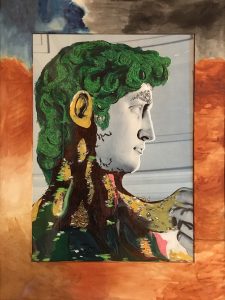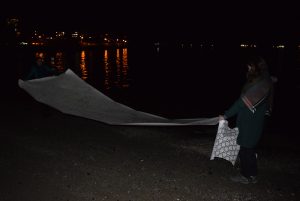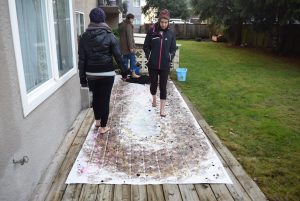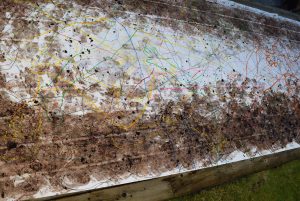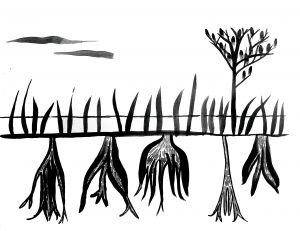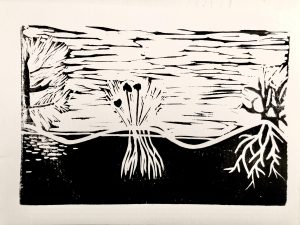Healing The Holobiont Collection
Reflections:
In a year dominated by a tiny microbe known as SARS-CoV2 we have all learned to more intimately understand the violence that bodies and psyches might endure when they ‘come into contact’ with microscopic beings.
But wait, there is more! Surrounded by and suffocating in human angst and suffering we are also drawn to understand the vast and complex networks of life in which our bodies exist, endure and nourish. As we learn to re-conceptualize our human forms as multispecies ecologies, the vision of the microbial ‘Other’ begins to blur at the edges. The ‘Other’, it turns out, is ‘none other’ than the Self when it comes to microbes. We evolved with them, we rely on them for our immunity, our development, our digestion, our metabolism and our cognition. When we die, microbes (if we let them) gently return our bodies to the soil to support other life forms in the endless cycles of nature.
The practice of creating art that tries to express this blurring has been liberating – a certain freedom is enacted by drawing a brightly dipped brush across the quintessential image of an exceptional (male) body, mixing garish colours and polluting such an iconic vision of human perfection. I have had the joy of doing this in the company of my daughter who has wisely admired my budding talents. Who knew that academia could be both seditious and fun?
We were a team, my daughter and I. We agreed on the desirability of taking David “down a notch or two”, even if we didn’t know exactly what we were doing at the time. Seeing that green hair led us to the beauty of green mossy hair. Watching the bark spread across his marble visage felt like a liberation of sorts: a soft calamity of crumbling marble and patriarchy, a subtle flip-flop of accepted notions of European beauty and power. As the moss and mycelia spread into the porosity of his stone face, we feel a rising femininity, quietly and stubbornly disintegrating the hubris of human exceptionalism.
Will we look back at the pandemic of 2020 and see it as a beginning of sorts? We hope so.
Joan & Rebecca
Reflections:
Our project, “The holobiont’s healing process,” consisted of a set of practices oriented toward experiencing the holobiont in order to feel it, sense it, and heal it, understanding it as an entity around and amid us whose wellbeing has been profoundly affected by the Anthropocene/Capitalocene/Colonialitycene. This process took place in both rational and extrarational ways, embracing multiplicity, messiness, and abigarramiento. Our main focus was on healing practices themselves, we chose to do our practices while interacting with a piece of paper that could carry the prints of our process of healing. The resulting evidence of this project is not a representation or depiction of the holobiont, not even of the process of healing, but rather a physical imprint of our practices to heal by experiencing the holobiont.
Underpinning these practices, there was the assumption that there is no separation between spirituality and materiality; mind and body; the individual and the community; the parts and the whole. All our actions intended to be, thus, simultaneously spiritual, intellectual, and physical (embodied practices). Our practices focused on making tangible the intra and interconnections of different metabolisms, revealing that all metabolisms are part of a nested network that ties together the tiniest cell with the whole universe. That network is what constitutes the holobiont.
In an attempt to help us move beyond the frames of modernity/coloniality, we understand our practices as cyclical and not sequential phases organized in a linear arrangement. We chose a cyclical temporality, aligning our practices with different moments of the day/night cycle of the earth:
- The Afternoon practice invited us to experience the dissolution of the individual by drawing overlapping imprints of different body interactions with the paper. Drawing each-other´s silhouette was a form of bonding and trusting by embracing intimacy and vulnerability, letting go of our defensive barriers. By tracing our imprints, we could see the connections of all beings; our imprints are constituted by the parts of ourselves that we leave behind (living and dead cells of the multiple organisms that conform us). The paper, in this sense, enabled a space for our bodies to exchange microorganisms, odors, and tactile experiences.
- The Night practice brought us to the beach, where we placed the paper on the foreshore. We stood on the paper right at the liminal zone where the ocean meets the land. This involved the interaction of our holobionts, the paper carrying our prints, the ocean, the sand, and all the interstitial organisms that live on the beach. Some interactions worked at a metabolic level as our bodies adapted to the winter water’s temperature, which is a result of the earth’s metabolism. Through a breathing technique, we connected with the swinging of the tide and synchronized our metabolisms with the ocean´s. The night practice gave us a sense of how fragile perceived boundaries are; we felt the dissolution of the borders between the sea, the land, and ourselves. The practice also entailed overcoming difficulty and accepting the discomfort and pain that the low temperature caused on us.
- The Sunrise practice invited us to witness the decomposition of multiple traces left on the paper — and the paper itself. We initiated this composting process by walking on the paper while stepping into mud and soil rich in organisms. Our steps were guided by a breathing practice oriented towards engaging all our pores; this involved all of our cells and their mitochondria, which are a legacy of our endosymbiotic origin. Again, we experienced the rhythm of our holobionts adjusting to cold temperatures and interacting with soil organisms. The breathing technique we exercised opened space for experiencing the subtle, the connection with the cosmos. By exchanging the energy of our micro-universe with that of the macro-universe, an effacing of the frontiers/boundaries takes place between these two dimensions. The practice implicated the soil, the paper, holobionts, the air, and the earth in a single and nested metabolism.
Feeling, sensing, and healing the holobiont expanded our perspectives, ways of feeling and being. We built a complex nest of experiential knowledge that involves ecological, spiritual and aesthetic aspects.“The holobiont’s healing process” project gave us something very rare in pandemic times. It allowed us to bond as people, to give each other happy moments, to experience friendship. It also opened space to experience and recognize connectivity with all beings far beyond the modern individual.
Inari Sosa-Aranda
Romina Tantaleán
Rosario Oyanedel-Frugone
Reflection:
We are an artist and a scientist (although really, we are one artist/sometimes_scientist and one scientist&artist). The above image is a linograph ink print on print paper carved by scientist&artist, based on an ink painting by artist/sometimes_scientist, which was itself painted according to the description of scientist&artist’s field site, a bog. At this bog, scientist&artist measures how land use change affects carbon cycling and greenhouse gas fluxes. This project — by which we mean the art project and the bog project — is ongoing. Next, on top of the negative space, artist/sometimes_scientist will render the microbes underneath the land who play crucial parts in cycling carbon in terrestrial ecosystems. As you appreciate our art, understand that although this subject does actually exist, it is likewise an imaginary ecosystem produced in the shared minds of interdisciplinary scholars like ourselves. The ways in which we envision and represent ecosystems realizes them.
G. Wolf the artist/sometimes_scientist
M. Nyberg the scientist&artist
View Invitation to Healing the Holobiont
